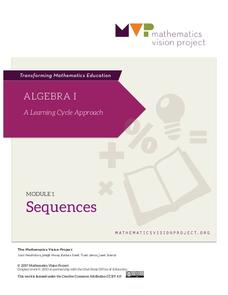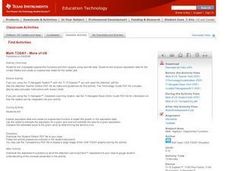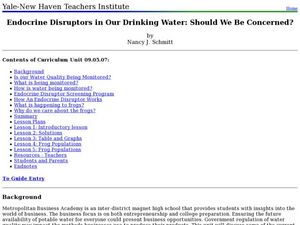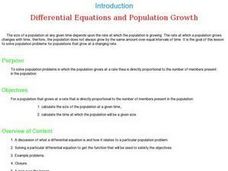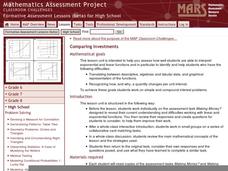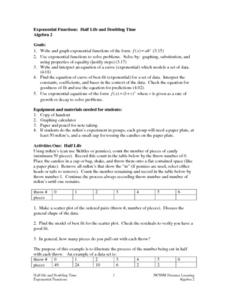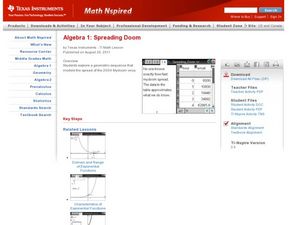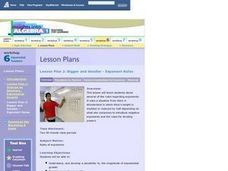Curated OER
Growth and Decay
In this algebra worksheet, students investigate growth and decay. They analyze the population of Winchester, Virginia to see what year had the most or least growth or decay. There are 4 word problems.
Curated OER
Outbreak!
Learners examine the spread of a disease. In this Algebra II/Biology lesson, students collect and analyze data as they simulate the spread of a virus. Learners brainstorm ways in which people can help to stop the outbreak of...
Mathematics Vision Project
Module 1: Sequences
Sequences are all about recognizing patterns. A module of 11 lessons builds pupils' understanding of sequences through pattern analysis. The practice connects the analysis to linear and exponential equations. This is the first module in...
Concord Consortium
Rule of 72
Find an easier way to double it. Using the price of an item and the Consumer Price Index, learners determine how long it will be for the price to double. Scholars calculate the length of time it would take for the price to double using a...
Macquarie University
Logarithms and Exponentials
Introduce logarithmic functions and their properties with a straightforward lesson plan. It provides an introduction to new material, examples, and practice problems. The variety of problem types keeps learners engaged while...
Rice University
Calculus Volume 1
Differentiate between calculus concepts. The beginning of a helpful calculus resource begins with a short review of functions and moves right into limits to define derivatives. The six-chapter resource continues with applications of...
Curated OER
More of U.S.
Explore graphical representation of a real-life data set and determine the exponential regression model for the data in your classroom. High schoolers also compare the estimated value to the given value by determining the percent error.
Curated OER
Endocrine Disruptors in Our Drinking Water: Should We Be Concerned?
Students investigate the different hormone contaminants in the water supply. In this math lesson, students analyze data tables and graphs. They demonstrate exponential growth and decay using frog populations.
Mathematics Vision Project
Quadratic Equations
Through a variety of physical and theoretical situations, learners are led through the development of some of the deepest concepts in high school mathematics. Complex numbers, the fundamental theorem of algebra and rational exponents...
EngageNY
Percent Rate of Change
If mathematicians know the secret to compound interest, why aren't more of them rich? Young mathematicians explore compound interest with exponential functions in the twenty-seventh installment of a 35-part module. They calculate future...
Curated OER
Carrying Capacity of Ecosystems
Students define population and carrying. In this algebra lesson, students explore exponential growth and decay based on animals and things that grow or decrease exponentially. They graph their findings and discuss their results as they...
Curated OER
Differential Equations and Population Growth
Students determine the size of the population at a given time. They calculate the time at which the population will be a given number. They observe how the population grows at the rate that is directly proportional to the number of...
Curated OER
Comparing Investments
Money, money, money. A complete lesson that makes use of different representations of simple and compound interest, including written scenarios, tables, graphs, and equations to highlight similarities and differences between linear and...
Curated OER
An Introduction to Functions
Students investigate the growth and decay of an exponential function. In this algebra activity, students apply properties of exponent solve problems. They identify any patterns they see in the graphs.
Curated OER
Exponential Functions: Half Life and Doubling Time
Students investigate the concept of exponential functions and how they increase in size over time. They simplify the functions in order to find the solutions that are possible and perform analysis of the curved line that is produced when...
Curated OER
How Much Data is That?
Students differentiate between exponential and logarithmic functions. In this algebra instructional activity, students use logarithmic properties to solve equations. They identify growth and decay of graphs.
Curated OER
Means of Growth
Students collect and graph data. In this statistics lesson, students analyze their plotted data using a scatter plot. They identify lines as having positive, negative or no correlation.
Curated OER
Oodles of Poodles
Students solve equations by graphing. In this algebra lesson, students differentiate between functions and relations. They use the TI to graph their equation and analyze the graph.
Curated OER
The Right Angle
In this algebra worksheet, 11th graders solve word problems creating a right triangle. Students determine the point and direction this turn of ninety degrees occurs. There are 4 questions with an answer key.
Mathematics Vision Project
Module 3: Polynomial Functions
An informative module highlights eight polynomial concepts. Learners work with polynomial functions, expressions, and equations through graphing, simplifying, and solving.
Curated OER
Spreading Doom
Students explore the pattern created by a sequence or series. In this geometry lesson, students relate the spread of a virus to the growth of exponential functions. They collect data as they analyze the sequence created by the growth.
Curated OER
Modeling Natural Disaster with Mathematical Functions
Ninth graders investigate the functional relationship of different environmental phenomena. In this math lesson, 9th graders create models of various natural disasters. They use logarithmic and exponential functions to interpret...
Curated OER
Reciprocals of Quadratic Functions
Eleventh graders investigate inverse functions. For this Algebra II lesson, 11th graders use their prior knowledge of linear, exponential,and quadratic functions to create a graph of an equation they have never seen before.
Curated OER
Bigger and Smaller - Exponent Rules
Students study rules regarding exponents. It uses a situation from Alice in Wonderland in which Alice's height is doubled or reduced by half depending on what she consumes to introduce negative exponents and the rules for dividing powers.


